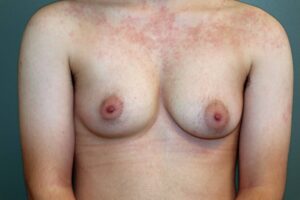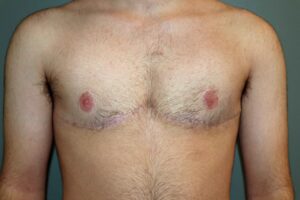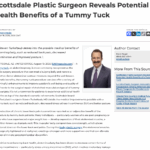
Scar healing from FTM or FTN gender affirming top surgery isn’t just about waiting for time to pass. It’s an active process that involves consistent care, lifestyle choices and patience. While your plastic surgeon’s skill sets the foundation for the quality of your scars, what you do after surgery plays a major role in how they ultimately look.
Factors That Influence Scar Formation and Healing
The excitement of seeing your post-surgery chest for the first time often gives way to the realization that the healing process is still just beginning. The incisions close and heal, strengthen over time and mature. This process can take a year or more.
During scar healing, there are some factors out of your control, like genetics, while others – like wound care, nutrition and activities – are directly in your hands. The ultimate goal is for thin, flat and nearly inconspicuous scars.
1. Surgical Technique and Skill
Your plastic surgeon’s precision, skills and operative decisions, including pertaining to wound closure along with their postoperative care protocol, are among the most important factors affecting the resultant scars. Less than desirable execution of surgery and postoperative considerations can and will lead to non-ideal and even quite inferior results.
2. Skin Type and Color
Individuals with darker skin tones tend to have a higher risk of hyperpigmentation and the formation of thicker, more prominent and noticeable scars. Natural red-heads have a predisposition for forming very red, elevated and often wider scars.
3. Genetics
Some people are simply more prone to forming thicker scars, hypertrophic scars, keloids or even wider scars due to their genetic makeup. Conditions such as Ehlers–Danlos syndrome can increase the likelihood of wider scars.
4. Age
Younger people usually heal faster, but their scars can sometimes be thicker and more noticeable because their skin produces collagen more aggressively. Older skin may heal more slowly but often results in softer, less visible scars.
5. Postoperative Care
Adhering to your surgeon’s wound-care plan is one of the most controllable factors in scar healing. This includes the temporary restriction of various activities which can adversely impact scar healing, use of scar therapies and sun protection.
6. Activity Restrictions
Early on, activities that can have a distracting (pulling apart) effect on the wound margins can lead to wider, thicker and undesirable scars. Therefore, it is strongly recommended to avoid these types of activities for an average of around three months post-surgery. In some situations, modifications can be made on an individualized basis to reduce this time down to two months.
7. Nutrition and Healing
Your body needs the appropriate nutrients and an adequate amount of them in order to ideally heal wounds after surgery. The amount that you will need are above your normal baseline levels and includes proteins, calories and other nutrients. This is not the time to diet and restrict one’s intake of the important building blocks of healing. Limiting these important elements can result in delayed healing and wider, inferior scars – detracting from the overall surgical outcome.
The following are a few of the more important agents needed for healing:
- Protein: The building block for collagen production. Aim for high-quality sources such as beef, poultry, fish, eggs, beans and Greek yogurt. Diverse sources are important. Vegans and vegetarians are at a much higher risk for deficiencies of the proper proteins needed for healing.
- Vitamin C: Essential for collagen synthesis and immune support. Found in citrus fruits, berries, bell peppers, and leafy greens. Vitamin C supplements are recommended.
- Multivitamins: These contain a broad spectrum of vitamins and nutrients that are crucial for the healing process.
- Zinc: Important for cell repair and immune health, this is typically found in multivitamins. Other sources include nuts, seeds, lean meats and legumes.
- Vitamin D: Has several important roles in the wound healing process including accelerating it. It also strengthens the immune system and has anti-inflammatory and anti-bacterial properties.
- Hydration: Adequate water intake helps maintain skin elasticity and supports nutrient transport to healing tissues.
8. Avoiding Smoking and Vaping
Smoking and vaping can have major negative impacts on the healing process. The major way that this occurs is by reducing important blood flow to the tissues. By doing so, there is a reduction of crucial oxygen and essential nutrients that is delivered to the tissues and is absolutely necessary for the healing process. This deficiency can lead to delayed healing, wound separation, wide scars, poor wound strength, infection and tissue necrosis (tissue death).
How to Care for Your Surgical Scars
While some scar formation is inevitable, there’s a lot you can do to help them fade and soften over time. Here’s how to give your scars the best chance of healing well:
1. Follow Your Surgeon’s Instructions
It’s simple but critical: follow your post-op care plan exactly. Your surgeon’s instructions are tailored to your body, your procedure and your healing progress.
2. Protect From Sun Exposure
UV light can darken scars and make them more noticeable. Keep your chest covered or apply a broad-spectrum sunscreen with zinc oxide or titanium dioxide for at least 6–9 months. Sun-protective clothing with a high UPF rating is an excellent investment.
3. Use Silicone Scar Therapy
Silicone gel sheets or topical silicone gels can significantly improve scar appearance by hydrating the tissue and regulating collagen production. This treatment usually starts 3–4 weeks after surgery, once incisions are fully closed and scabs have naturally fallen away.
For best results, use silicone therapy generally for at least 6 months, and in some cases up to a year. Silicone tape/sheets should be worn 16 or more hours a day, if possible, while silicone gels are typically applied twice a day.
4. Avoid Strain on the Incisions
Limit movements and exercises that stretch your chest or cause pulling at the incision lines during the initial healing period – ideally about 12 weeks.

A.) Before FTM Top Surgery

B.) After FTM Top Surgery
The Bottom Line
FTM and FTN top surgery is a life-changing step, aligning your physical appearance with your true self. While the presence of scars is a normal and unavoidable part of surgery, there’s much you can do to influence their final look.
A combination of skilled surgical technique, careful postoperative management, good nutrition and scar-specific treatments can make a remarkable difference over time. (Photos A and B)
Your FTM and FTN Top Surgery Specialist
Dr. Steven H. Turkeltaub, a plastic surgeon board-certified by the American Board of Plastic Surgery, has over 38 years of experience in cosmetic and reconstructive breast surgery. He provides personalized care to help his female-to-male (FTM) and female-to-nonbinary (FTN) patients achieve excellent results while minimizing scars and complications.
To learn more about your options for gender affirming top surgery or to schedule a consultation, please call the Arizona Center for Aesthetic Plastic Surgery at (480) 451-3000 or contact us by email.





